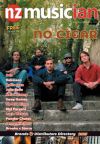Tutors’ Tutorial: Hunting For Noise
Tutors’ Tutorial: Hunting For Noise
You’re a guitarist, and you’ve been carefully crafting a new tone for weeks for your next show. The day arrives, you plug in on the stage only to find your amp buzzing and humming like a swarm of bees chasing some Mongolian throat singers.
Everyone stares in horror and you are forced to run from the venue in a shame that is dark and absolute. Your band don’t get paid and go back to their day jobs, their musical dreams dashed. And all because you didn’t properly protect your guitar from noise. Shame on you.
Guitarists are strange birds – slaves to a decades old technology that has changed little since its invention way back in the middle of last century. One thing that has notably changed since then is the ever increasing amount of powered appliances and audio gear that we use around us. All of these items spew out electromagnetic radiation which our poor old guitars readily take on board to be amplified as noise. Cold, systematic hunting and eliminating these pesky noises is our goal here. Let’s stalk.
We’ll start with the simplest electric guitar rig – a guitar, a cable and amplifier. Any tracking begins at the end – the amplifier. Turn it on without anything attached, and if it’s really noisy you’ve found your culprit – easy! Well, also not easy, because your amp should be relatively quiet on its own, and so you might want to take it to a qualified repair merchant to have it looked at. Bummer.
Assuming your amp is pretty quiet, next plug in your guitar and turn the volume down to eliminate that from the equation. If there is suddenly new noise added to your signal the culprit is your cable, which you should promptly replace with a quality shielded one.
If it’s not that either then there is the guitar itself. Turn the guitar volume all the way up. If the amp is at a reasonable volume we’ll more than likely be hearing a combo noise of both hum and buzz.
‘Hum’ is low frequency noise and is induced into your signal by any nearby mains transformer – power supplies for example. The way to combat hum is simply getting physical distance between you and and that transformer’s electrical field. You can easily find the culprits by turning nearby transformers off and on, one by one, until you find the main perpetrators, then move them further away.
The next culprit is ‘buzz’, which is higher frequency content noise, the noise which disappears on some guitars when you touch the strings, and the noise radiated by computer monitors and dimmer switches.
The way to reduce buzz is by what those in the biz (the science biz – or ‘science’) call a Faraday cage – more commonly known as a shield. A shield is a conductive copper sheet installed inside your pickup cavity, surrounding everything within the cavity. It is electrically continuous, connected to the guitar’s common ground point, and works by capturing radiation before it reaches the components and wires, corralling the errant signals to your ground connection away from your signal wire. Boom – buzz be gone!
It can be very inexpensive to shield a guitar using household products, a process covered by NZM before, so you may be surprised to find some rather expensive guitars (eg: American Stratocasters) not coming properly shielded, while other cheaper models (Danos for example) are, and have always been shielded well. (The metal outer of lipstick pickups forms a shield around the coil.)
‘Ah ha’, you may be thinking, what about the pickups? Don’t they jut out of the cavity? Aren’t these outside of the shield and thus prone to the radiation we are trying to hide from? An astute observation, and the answer is, ‘Yes’, yes they will. The shielded innards mean there will be a lot less noise induced, but some will still get in through the pickups, especially single coil pickups.
Shielding the pickups is possible, but more delicate and best left to a tech while the old ‘rotate your body to the point of least noise’ tactic seen in many home studios and old venues is what to use in lieu. An old trick, not so very good, but a working last resort if needed.
Using these tips, lovely loud amplified guitar clangs can now be yours, noise free(ish)! You need never run ashamed from a gig again. Well…
James Dansey is the Head Studio Supervisor at SAE Institute and when not touring the world mixing live music and obsessing over guitar tone, he can be contacted at j.dansey@sae.edu.

